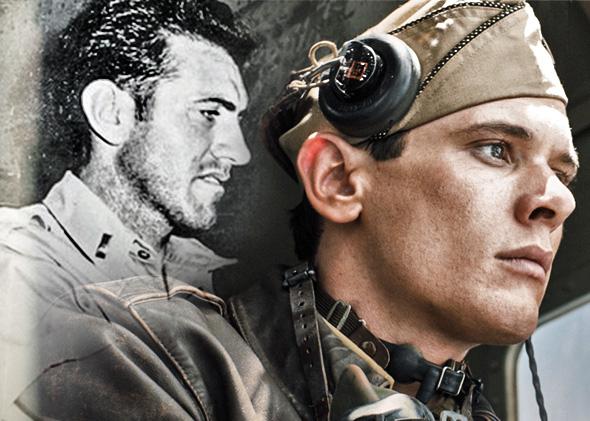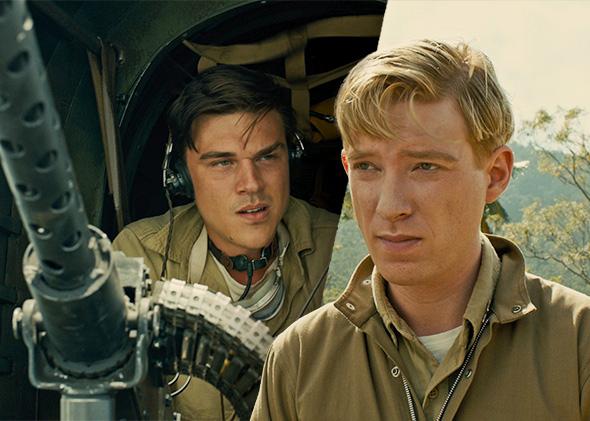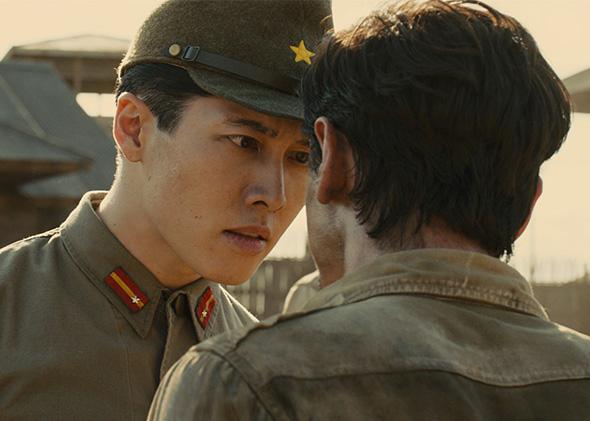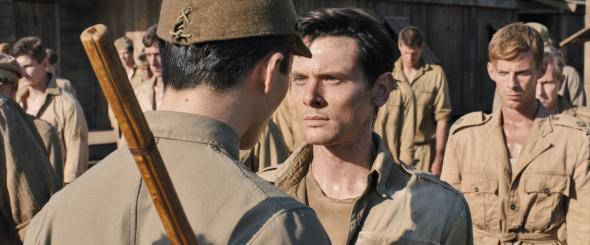Laura Hillenbrand’s biography Unbroken: A World War II Story of Survival, Resilience, and Redemption tells the extraordinary story of Louis Zamperini, an Olympic runner-turned-war-hero. Against nearly impossible odds, Zamperini managed to survive years of extreme deprivation and torture, first spending 47 days lost at sea after his plane crashed several hundred miles from Oahu, Hawaii, and then becoming a POW in Japan, where he was targeted by a malevolent, violent commander named Mutsuhiro “the Bird” Watanabe.*
Hillenbrand’s bestseller has now been adapted for the big screen, with a screenplay by Joel and Ethan Coen, Richard LaGravenese, and William Nicholson. Angelina Jolie, who befriended Zamperini before his death this past July at the age of 97, directed and co-produced the film, and Jack O’Connell stars as Zamperini. Several film reviews have criticized Unbroken for being “watered-down” in its storytelling; the Hollywood Reporter notes that “the half-hour the film spends at sea simply can’t render the sheer, slow agony the book so effectively conveys.” So how closely did the filmmakers stick to Zamperini’s account, as told by Hillenbrand?
Quite closely—though, as those reviews have mentioned, a lot of details are left out from the 137-minute running time. The film ends, for instance, soon after the war ends, whereas Hillenbrand spends several chapters delving into what occurred post-war. Below, I take a look at some of the other major ways the movie reflects, and occasionally diverges from, its source.
An Olympic Track Star
In the film, Louis’s career as a track star is kick-started by accident: He gets caught hanging out under the bleachers at his high school, trying to sneak a peek at the girls sitting above him. He sprints away onto a track full of runners—including his older brother Pete (Alex Russell), who is impressed by Louis’s speed. Pete takes on the role as Louis’s coach and mentor, training him daily.
According to Hillenbrand’s book, however, the circumstances that led to Zamperini’s track accomplishments were a little different. Some ninth-grade girls were organizing an interclass track meet, and “Louie was the only male who looked like he could run.” They sweet-talked him into participating, and he lumbered to last place in the race. Embarrassed, he hid under the bleachers. “The coach muttered something about how that kid belonged anywhere but in a footrace,” Hillenbrand writes. Pete was then determined to train a reluctant Louie, who initially “hated running,” but grew to love the applause from the stands as he improved in subsequent meets.
Over the course of a couple of years, Zamperini would go on to break records, including some of Pete’s. One of those records is played out in the film: In 1934, at the Southern California Track and Field Championship, he ran a mile in 4 minutes, 21.3 seconds, “shattering the national high school record set during World War I by more than two seconds.”
Also seen in the film is Zamperini’s participation in the 5000-meter dash at the 1936 Olympics, where he placed eighth but broke another record: He ran the final lap in just 56 seconds, beating the previous Olympic record of 69.2 seconds, “a monumental feat.” (The film doesn’t mention it, but Zamperini caught the eye of Adolf Hitler, who wanted to meet him after the race. “Ah, you’re the boy with the fast finish,” Hitler apparently said to him in German, via a translator.)
Adrift In the Middle of the Ocean

Photo illustration by Slate. Photo courtesy National Archives and Records Administration via Wikipedia, Universal Films.
Zamperini enlisted in the U.S. Army Air Forces in 1941 and earned the rank of second lieutenant.* In May 1943, while stationed in Kualoa in Hawaii, he and his crew were ordered by the lieutenant in command to search for a missing B-24. At the lieutenant’s insistence, Zamperini and his crew took the Green Hornet, a “haggard” B-24 even though crew member Russell “Phil” Phillips (played by Domhnall Gleeson in the movie) warned their commander that the plane wasn’t “airworthy.” A second plane, the Daisy Mae, accompanied them on the search.
The film sticks pretty closely to the accounts described in Hillenbrand’s book. Not long into the flight, the Green Hornet began to drift and eventually crashed into the Pacific Ocean due to mechanical difficulties. Of the 11 men on board, only Zamperini, Phillips, and Francis “Mac” McNamara (Finn Wittrock) survived and managed to take refuge in two inflatable life rafts. Their circumstances were dire: The provisions box was lost in the crash, and the life rafts were ill-equipped, lacking a mast and sail, a first aid kit, a flashlight, and other necessities that would be included in standard military life rafts the following year. Among the few things that were on the Green Hornet’s raft were military-issued chocolate bars, a few half-pints of water, a flare gun, sea dye, fishhooks, and a fishing line.

Photo illustration by Slate. Photo courtesy Universal
As seen in the film, McNamara was especially anxious following the crash, and he ate all of the chocolate overnight. Zamperini tried to reassure his comrades that they’d be rescued soon. Around the third day in, a search plane failed to notice the flares that the survivors used to signal their location. A pattern developed that is played out on screen: They would go several days without water before a storm occurred and they were able to collect rainwater in empty cans. They would also go days without food, until they could kill a bird that landed on their boat and use it as fish bait. (The putrid-smelling birds themselves were too disgusting for them to get past their lips.)
Around two weeks in, Zamperini began praying aloud. “He had no idea how to speak to God, so he recited snippets of prayers that he’d heard in movies,” Hillenbrand writes. Weeks into their being stranded, one of their rafts was indeed destroyed by Japanese gunners from above, forcing the three of them to pack uncomfortably into the remaining raft. Around the 30th day, McNamara died. After putting his body out to sea, Zamperini prayed for himself and Phillips, “vowing that if God would save them, he would serve heaven forever.” On the 47th day, they were captured by a Japanese boat.

Photo courtesy Universal Pictures.
Prisoner of War
It’s not seen in the film, but Zamperini and Phillips were initially treated quite well by their Japanese captors, since they were worth more alive than dead. Each man had lost “about half of his body weight” since the crash, and once the boat landed on an island, they were attended to in an infirmary by a doctor and fed well over the course of three days. The respite was brief: They were informed by the deputy commanding officer that a freighter was coming to take them to Kwajalein, known as Execution Island; Zamperini recalled that he told them, “After you leave here, we cannot guarantee your life.”
Other major details are found in both Hillenbrand’s book and Jolie’s adaptation, however. At Kwajalein for several weeks, the castaways were barely fed and held in separate cells; Zamperini lied to interrogators about the Allies’ strategy and technology. Instead of being killed, Phillips and Zamperini were eventually separated, the latter sent to Omori Camp in Japan. Mutsuhiro “the Bird” Watanabe (played by Japanese musician Miyavi), a young corporal, singled out Zamperini for excessive torment. Hillenbrand cites Zamperini’s status as an officer and famous Olympian as the reason for the Bird’s obsessive targeting; here’s how she describes their relationship:
Though there were hundreds of POWs in camp, this deranged corporal was fixated on Louie, hunting the former Olympian, whom he would call “number one prisoner.” Louie tried to conceal himself in groups of men, but the Bird always found him.
The film paints the Bird as a violent, sadistic man, and the book backs up this characterization with far more detail. His arrival at Omori made already despicable living conditions (Japanese camps were notorious for ignoring POW tenets set up by the Geneva Conventions) a nightmare. A camp accountant said he “was satisfying his sexual desire by hurting [the prisoners].” The Bird also allegedly tied a 65-year-old POW to a tree for days and practiced judo on an appendectomy patient, cruel acts that aren’t shown in the movie. (On the other hand, the film attributes at least one act inaccurately to the Bird: Zamperini was forced to race a Japanese runner after camp officers discovered he was a former Olympian, but in real life this happened before the Bird and Zamperini had crossed paths.)
Zamperini did indeed appear on Radio Tokyo to renounce an earlier NBC Radio broadcast that had pronounced him dead, as seen in the movie; his family was relieved to learn his fate. Also depicted in the film is the radio producers’ intent to use him as a propaganda tool; they asked him to read other, pre-written statements over the radio in exchange for living more comfortably with other propaganda prisoners, but Zamperini refused. He was returned to Omori.
At the end of 1944, the Bird was transferred to a different camp and promoted to sergeant; life at the camp became “immeasurably better,” Hillenbrand writes. (She also explains that his transfer was due to the influence of the dignitary Prince Yoshitomo Tokugawa, who visited Omori several times and pushed the Red Cross and the war office to do something about the Bird’s cruelty.) However, Zamperini was transferred to a new camp in Naoetsu along with other POWs in March 1945, where, as in the movie, he crossed paths again with the Bird, who was just as ruthless with him as he was before.
In one camp scene in the movie, the Bird orders all of the other prisoners to line up and punch Louis in the face, one by one, in order to teach him “respect.” This actually did occur, for about two hours, though Zamperini wasn’t the only one at the receiving end of the beatings; several other POWs who, along with Zamperini, were accused of stealing food suffered as well. They later estimated that they had each been punched around 220 times.
Likewise, the pivotal, triumphant moment in the film when Louis holds a heavy wooden beam over his head for several minutes at the order of the Bird, is also chronicled in Hillenbrand’s book. One of the POWs who witnessed the feat while working nearby kept an eye on the clock and noted that Zamperini held the beam for 37 minutes before the Bird charged at him angrily, knocking him to the ground. Zamperini would later say of his endurance that day, “Something went on inside of me. I don’t know what it was.”
The Beginning of the End
Perhaps the most significant omission from the movie is a plot to murder the Bird. Around early August 1945, after the Bird told Zamperini that he planned to drown him, he and around a dozen officers hatched a plan:
The men would leap onto the Bird and pull him to the top floor of the barracks, overlooking the drop to the Hokura River. There, they would lash him to a large rock and shove him out the window. When he struck the water below, the rock would carry him under. He would never draw another breath.
On August 20, the POWs were informed by the camp commander that “the war has come to a point of cessation,” as seen in the film. They were then allowed to bathe in the river, where they were spotted by an American plane. The POWs were elated; the Japanese recoiled and withdrew. The Bird, as indicated in the closing credits, managed to slip away before the Americans arrived; he went into hiding for several years after the war, and was never prosecuted.
Previously
How Accurate Is The Imitation Game?
How Accurate Is The Theory of Everything?
How Accurate Is Foxcatcher?
How Accurate Is Jersey Boys?
How Accurate Is Get on Up?
* Correction, Dec. 29, 2014: This post originally misstated that Zamperini was a member of the U.S. Air Force during World War II. He was in the U.S. Army Air Forces. The Air Force became a separate branch of the U.S. military in 1947.
